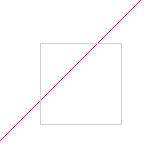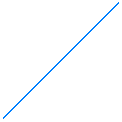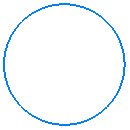Work with API KOMPAS-3D → Lesson 5 → Graphic primitives
We continue the cycle of articles on working with the CAD API KOMPAS-3D Sergey Norseev, an engineer-programmer of the All-Russian Scientific-Research Institute “Signal”, the author of the book “Development of applications for KOMPAS in Delphi”. C ++ Builder is used as the medium. In previous lessons on the API KOMPAS Basics and Drawing Design, we proceeded from the fact that KOMPAS is not running, in the Lesson Correct connection to KOMPAS we checked for the presence of already running KOMPAS and connected to it. In the last lesson, the Main Inscription dealt with how to fill the main inscription of the drawing. In this lesson, we’ll continue to look at the COMPASS system interfaces and finally begin to draw.

Before creating complex drawings, it is necessary to learn how to build graphic primitives, such as points, lines, segments, and circles. We will talk today about how to do this.
To build the point, use the ksPoint method of the ksDocument2D interface. Below is a prototype of this method.
')
Valid point styles are shown in the table below.

Dot styles
If successful, the ksPoint method returns a pointer to the created point, and in case of error, the value is zero .
Below is a fragment of a program that builds a point.
In this and subsequent examples from this article I will give only the most important parts of the code related to the topic of the article. How to get the ksDocument2D interface was described in previous articles in the series.
Before proceeding to the consideration of the construction of segments and circles, it is necessary to mention the styles of lines. KOMPAS offers several system line styles, each of which is defined by a positive integer. There are 25 styles in total. I will not give a complete list of them. I will name only the most frequently used.

Most used line styles
For a complete list of styles, see the documentation ( Parameter Structures and Constants / Constants / Constants of Graphic Objects / System Line Styles ).

Description of the system line styles in the SDK
To build a straight line, use the ksLine method of the ksDocument2D interface. Its prototype is:
This method has only three parameters: the coordinates of the point through which the straight line passes, and the angle (in degrees) between the straight line and the horizontal line. The angle is delayed counterclockwise.
If successful, the ksLine method returns a pointer to the created line, and in case of error, the number zero.
Below is an example of a program building a line.
I draw your attention to the fact that the ksLine method does not allow you to specify a line style. He always builds auxiliary lines, since lines in COMPAS are auxiliary constructions.
The figure below shows a fragment of a straight line.

Fragment straight
To build a segment, use the ksLineSeg method of the ksDocument2D interface. Here is its prototype:
If successful, the ksLineSeg method returns a pointer to the created segment, and in case of error, the value is zero .
Below is an example of a program building a segment.
The figure below shows the segment itself constructed by this program.

Section
To construct a circle, use the ksCircle method of the ksDocument2D interface. Here is its prototype:
If successful, this method returns a pointer to the created circle, and in case of error, the value is zero .
Below is an example of a program building a circle.
The figure below shows the constructed circle.

Circle
I draw your attention to the fact that the circle is constructed without designation of the center. How to build it will be discussed in one of the following articles of the cycle.
Conclusion
In this article, we learned about the line styles and learned how to build simple geometric objects: a point, a straight line, a segment, and a circle. In the next articles of the cycle, we will consider in detail the construction of more complex objects and operations on them.
To be continued, stay tuned to the blog.
 Sergey Norseev, author of the book “Development of applications for KOMPAS in Delphi”.
Sergey Norseev, author of the book “Development of applications for KOMPAS in Delphi”.

Before creating complex drawings, it is necessary to learn how to build graphic primitives, such as points, lines, segments, and circles. We will talk today about how to do this.
Point
To build the point, use the ksPoint method of the ksDocument2D interface. Below is a prototype of this method.
')
long ksPoint ( double x, // double y, long style). // Valid point styles are shown in the table below.

Dot styles
If successful, the ksPoint method returns a pointer to the created point, and in case of error, the value is zero .
Below is a fragment of a program that builds a point.
Document2D->ksPoint(100, 100, 0); In this and subsequent examples from this article I will give only the most important parts of the code related to the topic of the article. How to get the ksDocument2D interface was described in previous articles in the series.
Line styles
Before proceeding to the consideration of the construction of segments and circles, it is necessary to mention the styles of lines. KOMPAS offers several system line styles, each of which is defined by a positive integer. There are 25 styles in total. I will not give a complete list of them. I will name only the most frequently used.

Most used line styles
For a complete list of styles, see the documentation ( Parameter Structures and Constants / Constants / Constants of Graphic Objects / System Line Styles ).

Description of the system line styles in the SDK
Straight
To build a straight line, use the ksLine method of the ksDocument2D interface. Its prototype is:
long ksLine ( double x, // double y, double Angle). // This method has only three parameters: the coordinates of the point through which the straight line passes, and the angle (in degrees) between the straight line and the horizontal line. The angle is delayed counterclockwise.
If successful, the ksLine method returns a pointer to the created line, and in case of error, the number zero.
Below is an example of a program building a line.
Document2D->ksLine(100, 100, 45); I draw your attention to the fact that the ksLine method does not allow you to specify a line style. He always builds auxiliary lines, since lines in COMPAS are auxiliary constructions.
The figure below shows a fragment of a straight line.

Fragment straight
Section
To build a segment, use the ksLineSeg method of the ksDocument2D interface. Here is its prototype:
long ksLineSeg ( double x1, // double y1, double x2, // double y2, long style). // If successful, the ksLineSeg method returns a pointer to the created segment, and in case of error, the value is zero .
Below is an example of a program building a segment.
Document2D->ksLineSeg(100, 100, 150, 150, 1); The figure below shows the segment itself constructed by this program.

Section
Circle
To construct a circle, use the ksCircle method of the ksDocument2D interface. Here is its prototype:
long ksCircle ( double xc, // double yc, double rad, // long style). // If successful, this method returns a pointer to the created circle, and in case of error, the value is zero .
Below is an example of a program building a circle.
Document2D->ksCircle(100, 100, 30, 1); The figure below shows the constructed circle.

Circle
I draw your attention to the fact that the circle is constructed without designation of the center. How to build it will be discussed in one of the following articles of the cycle.
Conclusion
In this article, we learned about the line styles and learned how to build simple geometric objects: a point, a straight line, a segment, and a circle. In the next articles of the cycle, we will consider in detail the construction of more complex objects and operations on them.
To be continued, stay tuned to the blog.
 Sergey Norseev, author of the book “Development of applications for KOMPAS in Delphi”.
Sergey Norseev, author of the book “Development of applications for KOMPAS in Delphi”.Source: https://habr.com/ru/post/342030/
All Articles